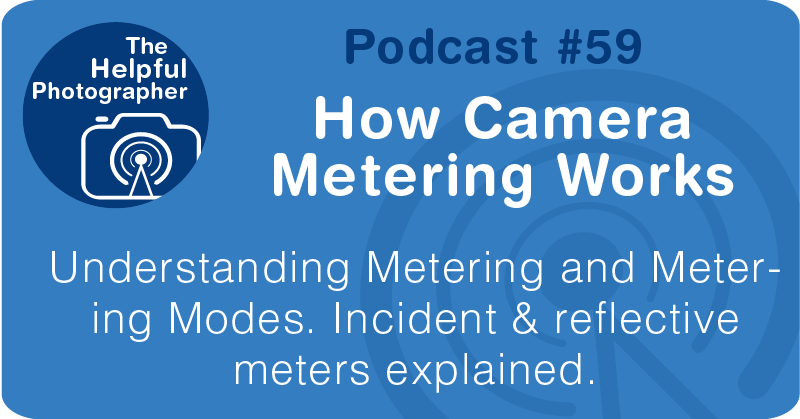How Camera Metering Works #59
Photo Tips Podcast: How Camera Metering Works #59

iTunes
Google
Spotify
Tune In
Stitcher
RSS
Pandora
Transcript
Photo Tips Podcast:How Camera Metering Works #59
These days every camera has a built in metering system, this has been the case for over 30 years. But what the heck is metering? Metering light is the act of measuring light volumes. You can either measure the volume of light reflecting off objects which is called a reflective reading or light that is falling on objects which is called an incident reading. So you have to use either a reflective meter or an incident meter. Reflective meters are what we have in our cameras and hand held spot meters. If you have ever seen a photographer look through something that looks like a radar gun that’s a reflective spot meter. Whereas incident meters are devices about the size of a walkie talkie with a white bulb at the top.
Most digital cameras have three different reflective metering options - spot, center weighted or evaluative/matrix or wide area metering. Spot metering inside your camera works just like a hand held spot meter. It takes a reading of a very small portion of the frame, normally an area that is equivalent to about 4% of the whole frame and in the very center point of your camera. Some cameras may allow you to tether that spot with a focus point, which means you’ll be able to take a reading from somewhere other than the center. On the other hand center weighted metering takes an average reading from a larger portion of the center of the camera; this can be anywhere from 60 to 80% of the center area of the image. Where as wide area metering can sample from 80-100% of your overall frame.
When you measure the light with any reflective meter , you are taking a reading of how much light is reflected from your subject into the meter’s viewing area. So if you have really dark areas and really bright areas it will be the average of the two. Again I said the viewing area; in other words if you are spot metering it is only measuring that tiny little area that the meter is looking at and will disregard the rest. So you will get different results if you use a measurement from a bright area versus a dark area. In a wide metering system the camera will take dozens of readings from different areas of the frame and then average them. This is why you will get a perfectly balanced exposure – well nearly perfect. To be clear, it will be perfectly balanced in terms of values, not in terms of aesthetics.
Here’s another way to understand what is going on. Imagine if you are taking a photograph of two pieces of paper, one black and one white, and the image area will be half black and half white. Your wide area metering will take a reading off of both areas and it will average the two values. The resulting value which is between the two will therefore render a perfectly black and white object. If however your image area is 2/3’s white and 1/3 black it means that the extra white area will dominate the averaging system, making the entire image darker and you will lose the black and white nature of the object. On the other hand if you do just the opposite with 2/3 black and 1/3 white you will find that the image is too bright as the black is now dominating the reading. So what this demonstrates is that the camera is constantly trying to get to the middle, this is good if you have a perfectly balanced image in terms of values. But if you don’t you will have to find another way to find an exposure that is not in the middle so that your objects render as they should, in this case where black is black and white is white. I’ll talk about how to overcome this problem in the next podcast.
At this point I’ve only talked about how reflective meters. But what about a hand held incident meters? Incident meters only measure the light that is falling on the subject area and disregards the values that are reflected into the meter, making it a much more accurate exposure and far more superior to a reflective meter. Because the meter is only looking at the incident light, you do not suffer from the 1/3, 2/3’s problem in the previous examples. The only disadvantage is that the meter needs to be under the same light source that is falling on your subject. For the most part this isn’t a problem but it is also a disadvantage; imagine if your subject is on the other side of the Grand Canyon… I know, it’s not likely to happen but you get the idea. But there will definitely be times when you are unable to get your meter under the same light as your subject. And in those rare situations a reflective meter would be superior. Another disadvantage of an incident meter is that it means you are carrying yet another device in your bag, and frankly my bag is heavy enough as it is. In the next podcast I’ll talk about how you can get a perfect meter reading from your camera when you have an imperfect scene.











